You can live comfortably in Paraguay on roughly €700 a month as a single person and about €1,800 for a family of four; city-center one-bedroom rent is around €390 and utilities are low (€43 monthly average). Groceries and dining are far cheaper than in Europe or the U.S., transport and healthcare costs are modest, and USD is widely accepted despite a volatile guarani; keep going to see detailed breakdowns of housing, food, transport, and healthcare.
Overview of the Average Cost of Living in Paraguay
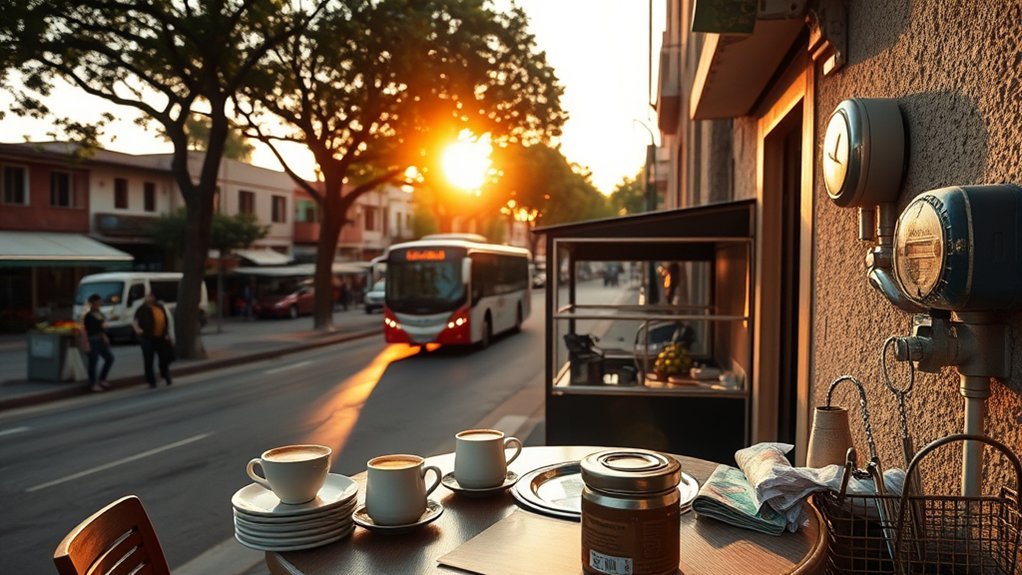
Although Paraguay’s living costs are among the lowest in South America, you’ll still want to budget carefully: a single person spends about €700 per month while a family of four averages €1,800.
Paraguay is very affordable, but plan carefully — singles spend about €700 monthly, families around €1,800.
You’ll find the average cost of living driven by affordable housing and low transport fares: a one-bedroom city-center flat averages 3,350,000 PYG (€390) monthly, buses cost ~PYG 2,400 (€0.26), and taxis start at PYG 8,600 (€1).
Food takes about 28% of your budget; staples like bread cost €0.65 and chicken fillets €5.15/kg.
Compared with regional peers, your euros stretch further here, but the standard of living depends on income: the average salary is around €370 monthly, covering roughly 0.7 months of expenses. Many locals supplement income through informal work or remittances to bridge the gap between wages and living costs.
That gap means you’ll likely need supplementary income or savings to maintain a comfortable standard of living if you rely on local wages alone.
Currency, Exchange Rates, and Inflation Trends

The official currency is the Paraguayan Guarani (PYG), with high-denomination notes like PYG 20,000 and PYG 100,000 reflecting past inflationary pressure.
As of November 2025, rates are approximately 7,040 PYG = 1 USD and 7,750 PYG = 1 EUR (exchange rates fluctuate daily), and USD is widely accepted while euros appear mainly in tourist-facing venues.
You’ll feel inflation’s impact on everyday prices and purchasing power—average monthly pay is about €370, which makes comparative cost shifts more significant for residents than for dollar-paid expats.
Official Currency and Symbols
Currency in Paraguay centers on the Guarani (PYG, symbol ₲), and you’ll typically see high-denomination notes—2,000; 20,000; 50,000; and 100,000 PYG—reflecting inflationary pressure that erodes purchasing power.
The official currency, Guarani, is used for most daily transactions, so you’ll budget local prices in PYG when estimating living costs.
Numerically, 1 USD ≈ 7,040 PYG and 1 EUR ≈ 7,750 PYG (November 2025 rates; exchange rates fluctuate daily), which helps you compare prices to foreign currencies.
In practice, many businesses accept USD and some restaurants and hotels take EUR, easing short-term visitors’ conversions.
Because inflation influences note denominations and purchasing power, you should monitor price levels rather than only nominal salaries when evaluating affordability.
Recent Exchange Rate Trends
When you track recent exchange-rate movements, the Guaraní has shown relative stability against major currencies but with measurable fluctuation—approximately 7,040 PYG per USD and 7,750 PYG per EUR as of November 2025—reflecting ongoing inflationary pressures and the need for periodic adjustments in pricing and wages. You’ll notice dual-currency acceptance: the Guaraní is dominant, but USD is commonly accepted, which cushions living costs for visitors and remittance recipients. Average monthly pay (~€370) highlights affordability issues when converted at current rates. Higher-denomination notes (₲20,000; ₲100,000) ease transactions amid inflation. Compare trends over time to gauge purchasing power and plan budgets. Note: Exchange rates fluctuate constantly; verify current rates before making financial decisions.
| Metric | Value (Nov 2025) |
|---|---|
| USD rate | ~7,040 PYG |
| EUR rate | ~7,750 PYG |
| Avg salary | €370 |
Inflation Impact on Prices
Although inflation has pushed prices up, Paraguay still offers goods about 30% cheaper than many neighboring countries.
However, you’ll feel the squeeze because average monthly pay (~€370) lags behind rising costs; at roughly 7,040 PYG/USD and 7,750 PYG/EUR (November 2025), currency fluctuations and higher-denomination notes like the ₲100,000 reflect persistent inflationary pressures that materially affect purchasing power for both locals and expatriates. Note that prices for food, utilities, and other essentials may have changed since publication; verify current costs before planning your move.
You should compare core expenses—rent, groceries, utilities—against income when evaluating living in Paraguay.
If you’re relocating, factor exchange volatility into budgets and contracts.
Housing and Rental Markets in Paraguayan Cities
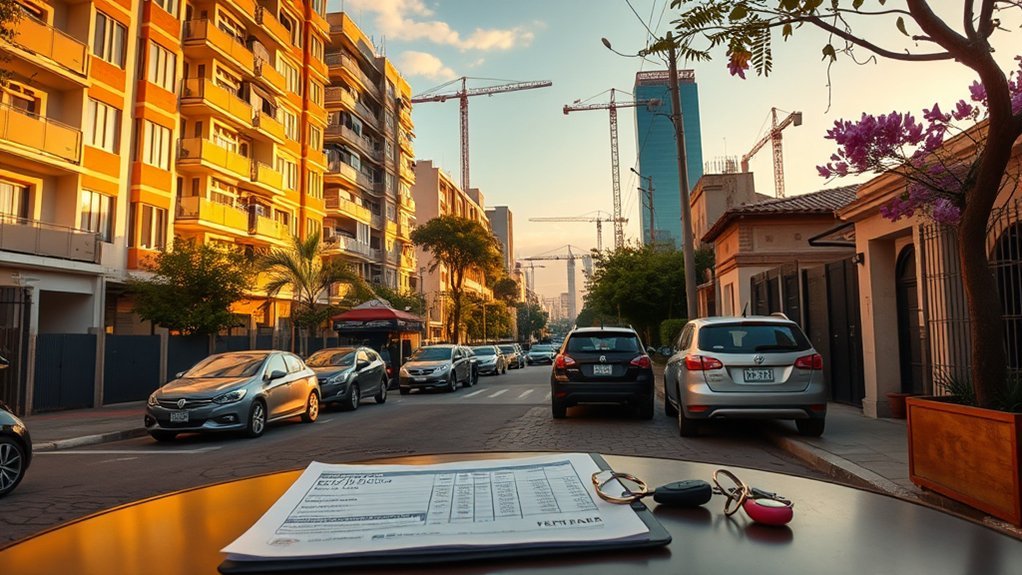
If you’re comparing urban housing costs, Paraguay’s rental and purchase prices stand out for their affordability: a one-bedroom downtown rents for about 3,350,000 PYG (≈€390) versus 2,660,000 PYG (≈€310) outside the center, while purchase prices run roughly 10,000,000 PYG/m² (≈€1,160) downtown and 4,850,000 PYG/m² (≈€565) in peripheral areas. Prices vary by region; Asunción typically costs 40–60% more than interior cities.
You’ll pay modest utilities and common fees: monthly housing costs including utilities average ~375,100 PYG (≈€43) for a single person.
Compared with Western markets, rent in Paraguay is about 79.1% cheaper than in the United States, so your housing budget stretches further.
Still, average monthly salary (~€370) covers only ~0.7 months of typical expenses, signaling that affordability is relative and depends on income source.
If you’re buying, lower per‑m² prices outside centers offer value for larger units; if renting, central one‑bedrooms cost more but remain inexpensive by international standards.
Typical Grocery and Dining Prices
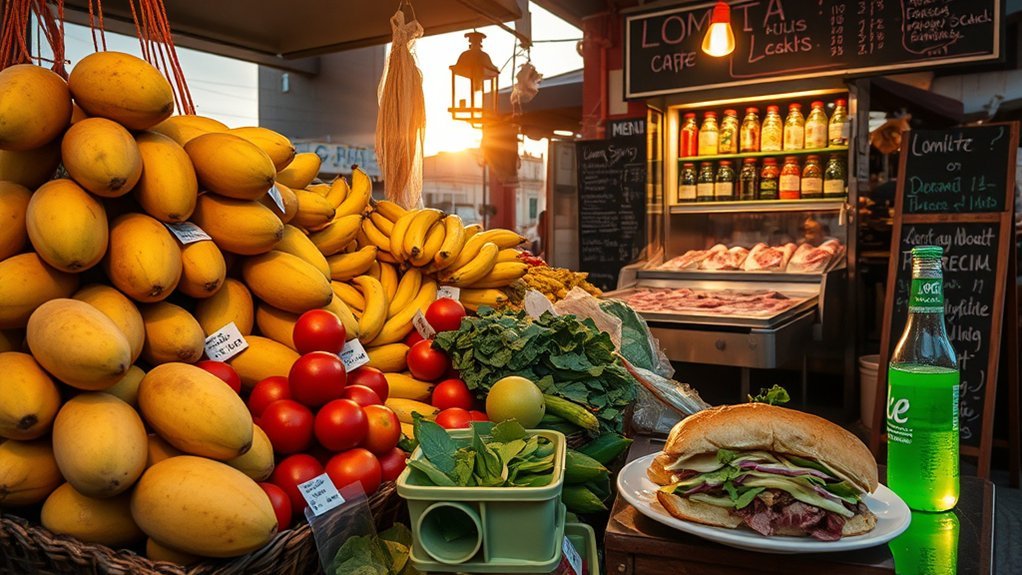
About 28% of your monthly budget typically goes to food in Paraguay, and groceries are particularly cheaper than in Western Europe: a 500 g loaf of bread costs €0.65, a dozen eggs €1.60, 1 kg of local cheese €2.85, milk €0.75/L, and bottled water €0.45 for 1.5 L, while common proteins like chicken and red meat run about €5.15/kg. Note that food prices may have increased due to inflation; verify current costs at local markets. You’ll find staples and proteins at low prices, so feeding yourself is economical compared with Western Europe. Eating out remains affordable: a typical lunch menu is about $4.64, and a dinner for two averages $23.50. Below is a quick comparative snapshot to guide budgeting.
| Item | Price | Category |
|---|---|---|
| Bread (500 g) | €0.65 | Staple |
| Eggs (12) | €1.60 | Staple |
| Cheese (1 kg) | €2.85 | Dairy |
| Chicken / Red meat (1 kg) | €5.15 | Protein |
| Lunch menu | $4.64 | Dining |
Transportation and Utilities Expenses
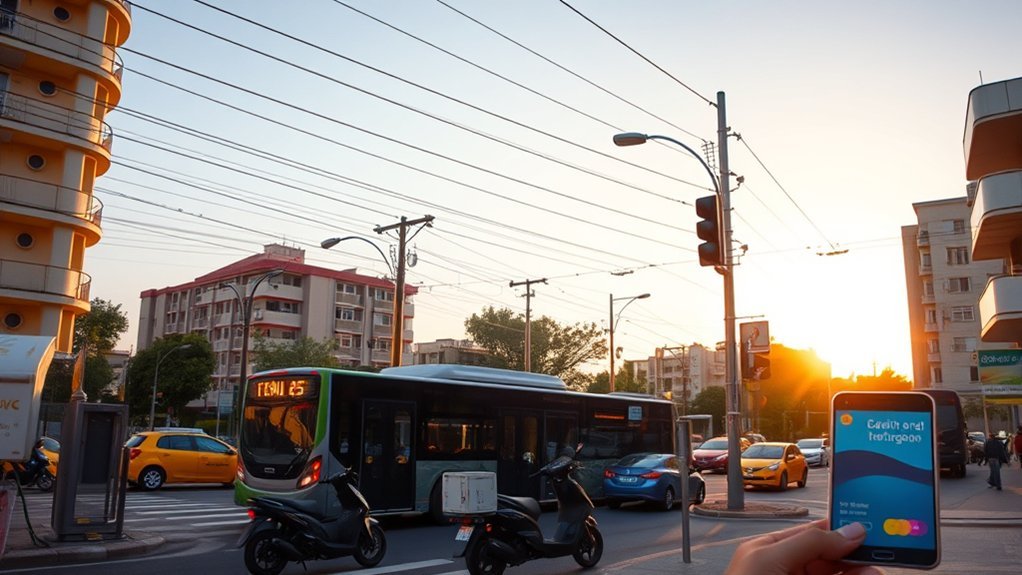
You’ll find public transport in Paraguay is very cheap: standard buses cost PYG 2,400 (~€0.26) and air‑conditioned ones PYG 3,600 (~€0.42), while a monthly pass runs about $33.90.
Taxis start at PYG 8,600 (~€1) with an average 8 km ride near €8.16, and petrol is low at PYG 7,700/ litre (~€0.90), so driving can be economical.
Basic utilities for one person average $23.70 monthly, and you’ll usually pay extra for internet depending on speed and provider.
Public Transport Costs
Public transport in Paraguay is particularly affordable: standard urban bus fares run about PYG 2,400 (~€0.26) and air‑conditioned buses PYG 3,600 (~€0.42), while single local tickets average $0.58 and monthly passes $33.90. You’ll find buses and local tickets cost a fraction of taxi or driving expenses, so commuting by public transport reduces monthly outlay considerably. For comparison, note starting taxi fares and fuel are higher, making buses the economical choice for daily travel. Utilities are modest, so combined transport+utilities remain low. Below is a concise overview.
| Mode | Typical Fare | Monthly Equivalent |
|---|---|---|
| Standard bus | PYG 2,400 (~€0.26) | — |
| AC bus | PYG 3,600 (~€0.42) | — |
| Local ticket / pass | $0.58 / $33.90 | $33.90 |
Taxi and Fuel
While buses and monthly passes keep daily commuting cheap, taxis and fuel offer different trade‑offs: an 8 km taxi ride runs about $8.16, so you’ll pay roughly the equivalent of two weeks of bus fares in a single trip, whereas petrol at ~$0.95 per liter keeps driving costs relatively low compared with many countries.
If you commute occasionally, taxis provide speed and door‑to‑door convenience but cost multiples of the $0.58 single ticket and can erase savings from a $33.90 monthly pass.
If you drive, fuel’s low price makes car ownership and ride‑sharing competitive, though vehicle purchase costs and financing matter — mortgage‑linked interest rates (20‑year avg ~9.88%) can affect broader affordability and influence whether you buy in the first place.
Utilities and Internet
Although utilities in Paraguay run cheap by regional standards, they’ll still factor into your monthly budget: expect about $23.70 for electricity, water and gas combined, plus roughly $16.80 for a 50+ Mbps internet plan. You’ll find utilities particularly lower than many neighboring countries, so basic living costs stay modest. Internet at $16.80 gives reliable speeds for remote work or streaming. If you commute, single public transport tickets cost about $0.58 and a monthly pass is ~$33.90 — compare that to fuel at ~$0.95 per liter if you drive. Choose monthly passes for frequent riders; driving becomes competitive only with low fuel use.
| Item | Typical Cost (USD) |
|---|---|
| Utilities (elec/water/gas) | 23.70 |
| Internet (50+ Mbps) | 16.80 |
| Single transport ticket | 0.58 |
| Monthly transport pass | 33.90 |
Healthcare, Insurance, and Medical Costs
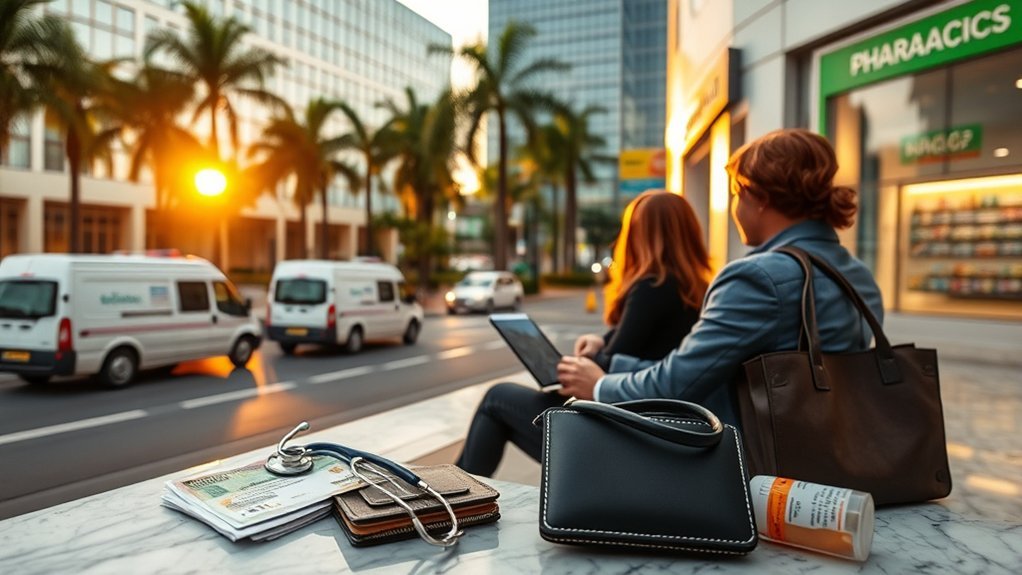
If you compare Paraguay’s healthcare expenses to many Western countries, you’ll see they’re substantially lower: average annual healthcare spending per person is about €445 (public system), general practitioner visits run near 300,000 PYG (~€35) and specialist consultations around 470,000 PYG (~€55), making routine care relatively affordable for residents and expats alike.
You’ll find public healthcare available at low direct cost, but quality and wait times vary, so many choose private clinics for faster, higher‑quality services.
If you want extensive coverage, expatriates frequently purchase international health insurance; premiums vary based on age, health status, and coverage level, but typically range from $50–$150+ monthly, providing access to private hospitals and overseas treatment. Your monthly outlays will depend on age, chronic conditions and service choice, yet typical monthly healthcare spending remains modest versus Western norms.
Expats often buy international health insurance for private-hospital access and overseas care; premiums vary with age and health.
When budgeting, compare private clinic fees, prescription costs and insurance premiums to decide whether local public care plus modest private use or full international coverage best matches your risk tolerance and financial plan.
Education, Childcare, and Schooling Expenses
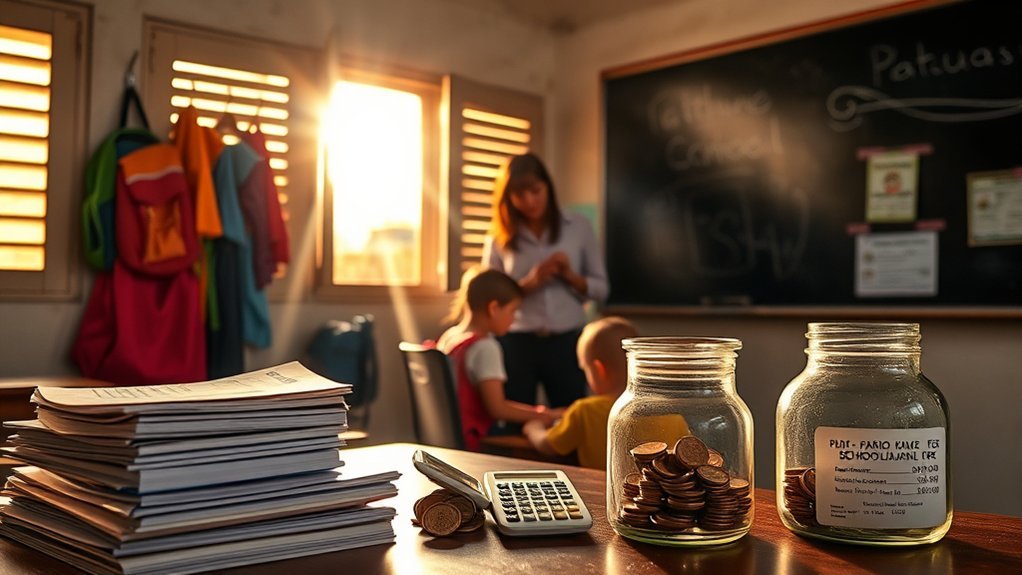
Healthcare and schooling both shape family budgets, so after accounting for medical costs you’ll want to estimate education outlays next. Public schooling is free and covers basic needs, so if you choose it your schooling costs can be minimal.
Private schools, however, range from €1,500 to €5,000 annually, so compare prices and curricula if you prioritize facilities or bilingual instruction. Bilingual programs (Spanish/Guarani) and specialized language offerings may carry additional fees.
Daycare and childcare average €100–€300 per month, a relatively low expense for working parents; budget €1,200–€3,600 per child yearly.
Extracurriculars like sports or music add €20–€50 monthly each, translating to €240–€600 annually per activity. University for locals runs about €1,000–€3,000 per year, but international students may pay more.
How Paraguay’s Costs Compare Regionally and to Europe
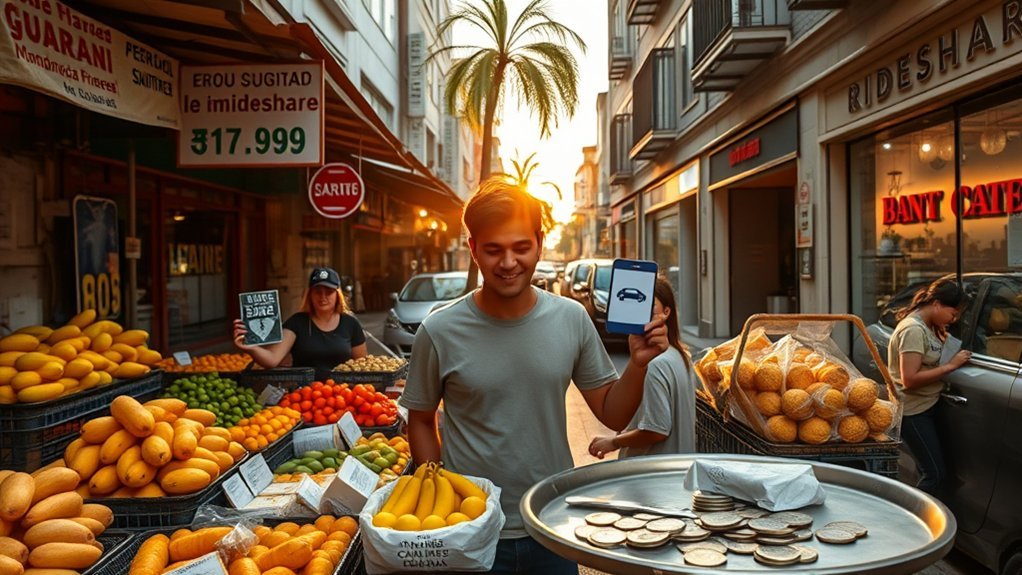
While Paraguay’s living costs are low across the board, they stand out sharply when you compare them regionally and to Europe: overall living expenses run about 64.6% below U.S. levels, basic provisions are roughly 30% cheaper than in neighboring countries, and rent—with a city-center one-bedroom near €390 in Asunción—is about 79.1% less than in the U.S.; a typical monthly budget is roughly €700 for one person and €1,800 for a family of four, underscoring that food, housing, and everyday goods cost greatly less than in Western Europe.
If you relocate from Europe, you’ll find grocery bills and staple items notably cheaper—bread, chicken, local cheese cost considerably less—so your purchasing power increases.
Compared to nearby capitals, Paraguay’s lower rent and reduced service costs cut housing and utilities significantly. For digital nomads or retirees, savings on accommodation and daily expenses often outweigh lower average wages.
Use the country’s price differentials to plan realistic budgets: you’ll likely need a fraction of European income to maintain a similar lifestyle, especially on housing and food.
Frequently Asked Questions
How Much Money Do I Need to Move to Paraguay?
You’ll need roughly €700 monthly for solo comfortable living, or about €1,800 for a family of four. Budget initial relocation savings for deposits, visa fees, and flights—expect at least three to six months’ living expenses upfront to cover initial setup costs.
How Far Does the US Dollar Go in Paraguay?
You’ll stretch the US dollar far: monthly living costs average about $647, 1.77× cheaper than the world average, so your dollar buys more housing, meals, groceries and transport compared with many countries.
What Is the Average Salary in Paraguay in Dollars?
The average salary in Paraguay is about €370 per month (approximately $400-410 USD depending on current exchange rates). You’ll see this is roughly 1.77 times lower than the global average, ranking Paraguay near the bottom worldwide, despite its relatively low living costs.
Is Paraguay a Good Place for Americans to Live?
Yes — you’d save a lot: living costs are about 64.6% lower than in the US. You’ll enjoy cheaper rents, no foreign income tax, and affordable daily expenses, making Paraguay attractive for many Americans seeking value.
Conclusion
You’ll find Paraguay is highly affordable: average monthly living costs for a single person run about $400–$600, while a comfortable expat couple can live on $1,200–$1,800. The guaraní maintains relative stability with manageable inflation. Housing is especially cheap — rents in Asunción are roughly 40–60% lower than in major South American capitals, though costs increase in central business districts. With data like “rent being half or less than regional peers,” you can plan realistically and stretch your budget further. Remember to verify current prices and exchange rates before making financial decisions, as costs fluctuate over time.


